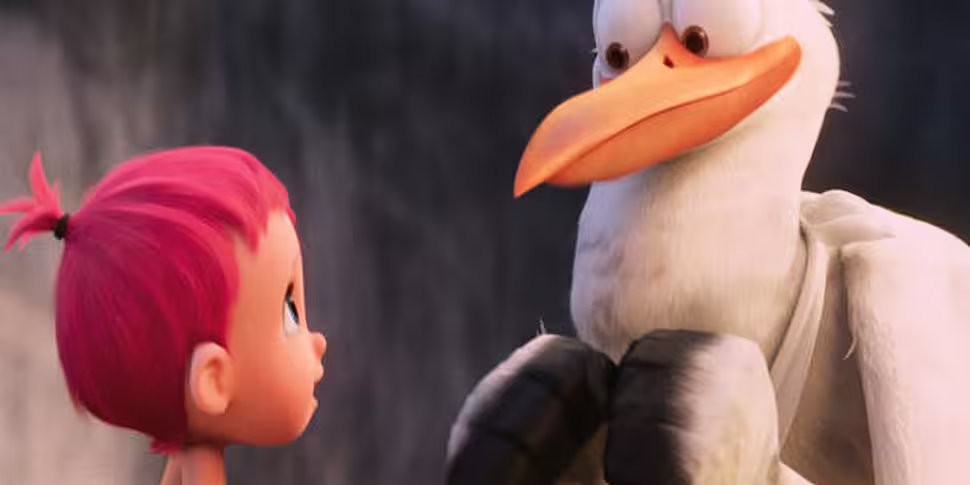Legend has it that storks deliver babies... or at least they used to. Now they deliver packages for a global internet retail giant … but all that’s about to change. Warner Bros. Pictures and Warner Animation Group’s upcoming animated film Storks takes audiences on a hilarious, action-packed and heart-warming adventure with an unlikely pair of heroes – ambitious delivery stork Junior and his friend Tulip, the only human on Stork Mountain – who team up to make their first-ever baby-drop, braving dangers and finding friendship in a wild and revealing journey that could make more than one family whole and restore the storks’ true mission in the world.
Famous for their white feathers, huge wing spans and big beaks, storks are known and loved the world over. Whether or not the mythical connection between storks and babies is true, they are among the planet’s most fascinating birds to learn about and observe.
Here are 10 fascinating facts about the tall, elegant flyers you may not have known.
The myth about storks and their precious cargo originated in Germany.
The age-old legend that storks deliver babies traces back to northern Germany during the Victorian era. Told by parents to children and passed on for generations, the fable is believed to have been inspired by the epic airborne migration of the European White Stork – which travels south during midsummer and returns nine months later.
There are over 19 species of storks around the world.
Storks don’t all resemble the alabaster-white birds pictured on the walls of many baby nurseries. With over 19 known species in the Ciconiidae family, these fascinating flyers come in an array of sizes and colors and live on every continent in the world, or nearly so – they have yet to be spotted on the frozen expanses of Antarctica.
From insects to French fries, storks are carnivores.
Different stork species dine on a whole range of food sources, including insects, fish, and even some amphibians, reptiles and small mammals. The Wood stork, which can be found in North and South America, sometimes eats snakes and alligators, while the open-billed stork of Africa and Asia feasts on aquatic snails. But when it comes to the largest stork of them all, the Marabou, even flamingos and other birds have to watch out when this giant is on the hunt for dinner.
Most storks are voiceless and some can sport a wingspan that can be almost double your height.
Unlike other birds, storks do not have a fully developed syrinx, or vocal box. Although the tall bird is generally viewed as silent, some stork species make grunt and hissing noises and loudly clatter their bills. Whether you hear them coming or not, you’ll definitely see a stork if it flies overhead! Certain stork species have wings that extend over eight feet long. When it stretches its great wings, the Marabou stork of Sub-Saharan Africa can cover over ten feet – that’s almost twice the size of a black rhinoceros, which stands just a little over five feet.
The European White Stork travels over 12,000 miles during migration.
To escape the cold winters of Northern and Central Europe, White Storks head south to enjoy the warmer environments of Sub-Saharan Africa in a journey that can keep them in the air for up to 49 days. Although storks typically spend winters in Africa, researchers have recently discovered vast nesting grounds for European White Storks in Portugal, where they can feast on everything from sea life to the discarded snacks of the tourists that flock to see them.
Storks build large nests and typically use them for years.
Some stork species use the same nest over multiple breeding seasons, adding new sticks and pieces of turf to the nest after they return from their annual migration. Over time, nests have been known to expand to a cozy nine feet deep and six feet wide, and bulk up to about 500 pounds. In the Croatian village of Cigoc, also known as the first European Stork Village, some nests perched on roofs have been home to generations of hatchlings for over one hundred years.
Stork chicks are raised by both of their parents.
A mating pair of storks divides their parenting responsibilities equally. During the incubation period, the female and male take turns keeping their eggs warm until the eggs hatch, then mom and dad both spend weeks bringing food back to the nest until their chicks are mature enough to light out on their own.
A stork’s nest was once seen as a symbol of good luck.
In ancient Rome, a stork’s nest on a household roof was thought to be a sign that the family has received the love and blessing of the goddess of Venus. Up until the 20th century, the Dutch and Germans regarded a stork’s nest as good fortune and even encouraged storks to build nests on their houses by building inviting platforms to attract the birds as they flew over.
Storks come in a variety of colors.
Storks aren't all covered in white feathers. Take the black stork, for an example. Widespread across regions in Europe, Asia and Africa, the dark yet colorful bird is black with a purple-green sheen, white feathers on the chest, and a bright red bill and red legs. The Painted stork of Asia is another member of the Ciconiidae family that dons many colors. Mostly white with black and white markings on its chest and wing feathers, the striking species also has pink feathers towards the tail and a vivid yellow-orange face and bill.
In India, the nests of a rare species of stork is protected by an “Army” of women.
A conservation brigade of 70 local women have come together to safeguard the nesting colony for the rare greater adjutant stork across three villages in India’s Brahmaputra River valley. A distant relative of the Marabou stork, this scavenger species – known locally as hargila (derived from the Sanskrit word for "bone-swallower") – once darkened the skies from Pakistan to Cambodia. Today, half the world’s population of greater adjutant storks – about 550 birds – now nests in the trees of this fortified haven, thanks to the efforts of the all-female “Hargila Army.”
Storks is out in Irish cinemas on Friday.
From Warner Bros. Pictures and Warner Animation Group, the animated adventure Storks is directed by Nicholas Stoller and Doug Sweetland, from a screenplay written by Stoller. It is produced Brad Lewis and Nicholas Stoller. The executive producers are Glenn Ficarra, Phil Lord, Christopher Miller, John Requa and Jared Stern. Edited by John Venzon. Music is composed by Mychael Danna and Jeff Danna. Check out more at StorksMovie.net.













